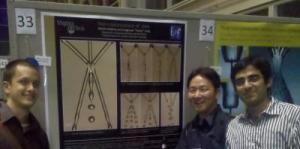Dec 2 2010
An illustration showing a scientific phenomenon that defies common intuition has garnered Sunghwan (Sunny) Jung, assistant professor of engineering science and mechanics at Virginia Tech, and his doctoral student, Navish Wadhwa, of Blacksburg, Va., the international Milton Van Dyke Award.
According to the engineering researchers, they worked with a specific fluid called silicone oil, often the base for hydraulic fluids or lubricants. This oil can also serve as an electrical insulator.
 This award-winning poster shows how the three jets of silicone oil are kept separate by a thin film of air, allowing the oil jets to bend and bounce off one another. From left to right are: Sean Gart, of Salem, Va., a Virginia Tech senior undergraduate, Sunghwan (Sunny) Jung, assistant professor of engineering science and mechanics at Virginia Tech, and Navish Wadhwa, his doctoral student, of Blacksburg, Va.
This award-winning poster shows how the three jets of silicone oil are kept separate by a thin film of air, allowing the oil jets to bend and bounce off one another. From left to right are: Sean Gart, of Salem, Va., a Virginia Tech senior undergraduate, Sunghwan (Sunny) Jung, assistant professor of engineering science and mechanics at Virginia Tech, and Navish Wadhwa, his doctoral student, of Blacksburg, Va.
"Intuition tells us that two or more jets of the same fluid impinging into each other will readily coalesce to form a single mass of fluid, and are well-studied phenomena," Wadhwa explained. "But when two jets of silicone oil with a diameter slightly smaller than 1 millimeter, impinging obliquely onto a vertical jet of the same fluid and same diameter, the jets from the side rebound off the middle jet instead of coalescing.
"This reaction is due to the lubrication effect of a thin film of air maintained between the two jets. The motion of the jets replenishes the air resulting in indefinitely sustained coalescence of the jets of the same fluid."
"This study can provide a better understanding of non-coalescence behaviors observed in many engineering systems such as oil separation, printing, and spray-cooling processes," Jung said.
Jung and Wadhwa's entry, "Non-coalescence of jets" was selected for the 2010 Milton Van Dyke award at the Gallery of Fluid Motion poster session at the 63rd annual meeting of the American Physical Society held in Long Beach, Calif. The competition attracted 75 poster entry submissions from all over the world, of which only three were selected for the award.